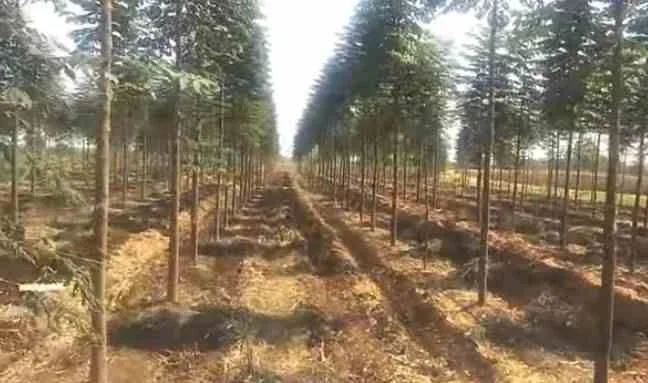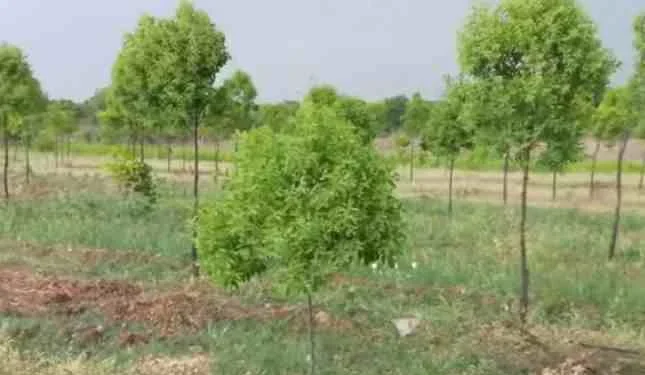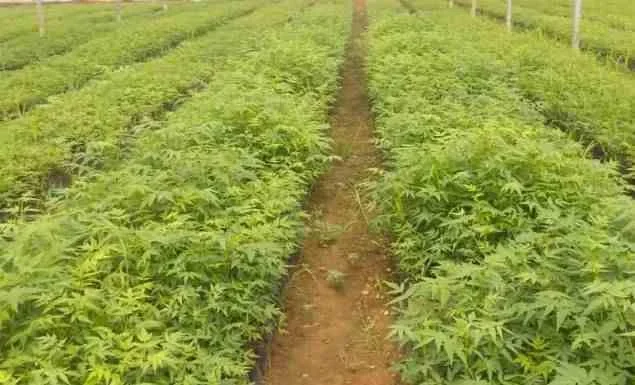Malabar Neem Farming: A Green Revolution in Agroforestry Practices
Malabar Neem, known as the ‘Green Gold,’ & melia dubia has emerged as a lucrative asset in the agricultural and economic landscape. This versatile tree, native to the Indian subcontinent, has gained popularity for its rapid growth and diverse applications ranging from timber to medicinal uses. In this article, we delve into the world of Malabar Neem, exploring its origins, economic significance, cultivation practices, alternative uses, and the challenges faced in its trade and sustainability.
Key Takeaways
- Malabar Neem is a fast-growing tree with a rich history and significant economic value, often compared to gold in terms of its lucrative potential.
- The tree’s economic impact is substantial, with its products ranging from high-quality timber to by-products utilized in various industries.
- Cultivation of Malabar Neem requires specific knowledge and practices to ensure healthy growth and optimal yield, making it a skillful endeavor.
- Beyond its primary use as timber, Malabar Neem has medicinal, cosmetic, and eco-friendly applications, highlighting its versatility.
- Sustainability and conservation issues are at the forefront of the Malabar Neem industry, with a need for balance between economic benefits and environmental health.
Digging Into the Roots: What’s Malabar Neem?

The Origin Story: From Ancient Times to Your Backyard
Let’s take a stroll down memory lane, shall we? Malabar Neem, known scientifically as Melia dubia, is like the unsung hero of the forestry world. It’s been around for ages, but only recently have we started to tap into its full potential. Originally found in the coastal belts of India and South Asia, this tree has made its way into our backyards, quite literally, thanks to its rapid growth and versatility.
- Ancient use: Primarily for timber and shade
- Modern applications: Diverse, including furniture, plywood, and even paper
Malabar Neem is not just another tree; it’s a symbol of growth and prosperity that’s been silently contributing to economies for centuries.
While it’s easy to confuse it with its distant cousins, Malabar Neem stands out with its unique characteristics. It’s a tree that’s not only easy on the eyes but also on the farmer’s pocket. We’re talking about a tree that can grow up to 40 feet in just a couple of years! Now, that’s what we call green gold.
Malabar Neem vs. Other Varieties: Spot the Difference
When we talk about the Malabar neem plant, we’re diving into a unique species that stands out in the forestry sector. Unlike its cousins, the Malabar neem has a rapid growth rate and a higher resistance to drought, making it a favorite among farmers. But let’s break it down a bit more, shall we?
- Growth Speed: Malabar neem shoots up faster than many other tree varieties, reaching maturity in just about 7 to 8 years.
- Drought Resistance: It can thrive with minimal water, which is a lifesaver in arid regions.
- Wood Quality: The wood of the Malabar neem is known for its durability and termite resistance, which is not as common in other varieties.
While other trees are busy taking their sweet time to grow, our Malabar neem is all about efficiency and resilience. It’s like the superhero of the plant world, with its cape fluttering in the wind as it stands tall against the challenges of nature.
Now, if we’re talking about the economic side of things, the Malabar neem is a clear winner. It’s not just a tree; it’s a profitable investment. And for those interested in goat farming in India, the Malabar neem’s leaves can serve as excellent fodder, contributing to the benefits of goat rearing alongside top goat breeds like Malabari.
A Botanical Breakdown: Understanding the Tree’s Anatomy
Let’s get up close and personal with the malabar neem tree, shall we? This beauty isn’t just a pretty face in the world of forestry; it’s a powerhouse of utility. The malabar tree stands tall with a robust trunk, and its branches spread out like a green umbrella offering shade and bounty.
- The bark is thick and rugged, a testament to its resilience against pests and diseases.
- Leaves are long, pinnate, and provide that lush greenery we all admire.
- Flowers are small and white, often unnoticed among the dense foliage, but they’re essential for pollination.
- The fruit, while not commonly consumed, is a small, fleshy drupe that wildlife finds irresistible.
In essence, every part of the malabar neem tree is a chapter in a story of versatility and strength. It’s not just about standing tall; it’s about providing a foundation for a multitude of uses that extend far beyond timber.
When we talk about the malabar tree, we’re not just talking about any old tree. We’re discussing a species that has carved out a niche for itself in the market. It’s a tree that understands the assignment of being economically valuable while also playing a crucial role in the ecosystem.
The Green Rush: Malabar Neem’s Economic Impact

Cash Crops and Climbing Profits: Analyzing Market Trends
As we delve into the world of Malabar Neem, it’s clear that this tree isn’t just another plant in the garden; it’s a burgeoning economic powerhouse. The demand for Malabar Neem has skyrocketed, turning it into a cash crop that rivals traditional agricultural staples. We’ve seen a shift in market trends, where farmers are increasingly turning their attention to more profitable ventures.
- Poultry
- Cow milk
- Vanilla
- Fish
- Sandalwood
- Coconut
- Lavender
These are just a few examples of the diverse income streams that savvy landowners are tapping into, with Malabar Neem standing tall among them. It’s not just about the timber; the tree’s by-products are also carving out their own niche in the market.
The versatility of Malabar Neem is its strength, allowing for multiple revenue channels from a single crop.
With the right strategy, landowners are finding that their investment in Malabar Neem can yield returns much sooner than expected. It’s a green gold rush, and we’re all in it to win it.
From Seed to Sale: The Journey of Malabar Neem Products
Let’s take a stroll down the path that every Malabar Neem tree takes, from a tiny seed to the products that reach the market. It’s a journey that’s as fascinating as it is profitable, and it all starts with the malabar neem plant price. This initial investment is a crucial step for farmers, and it’s where the economic tale begins.
Once the saplings are in the ground, the focus shifts to growth and eventual harvest. The malabar neem wood price fluctuates based on quality and demand, but it’s always a hot topic among us. We’re constantly keeping an eye on the market, ensuring we get the best return on our green gold.
The real magic happens when the trees mature. That’s when we talk about the malabar neem tree price in india, which can vary widely depending on the region and the buyer. But it’s not just about the timber; the leaves and bark have their own value, contributing to the overall profitability per acre.
Here’s a quick look at the potential earnings from a well-managed Malabar Neem farm:
| Stage | Investment | Return |
|---|---|---|
| Planting | Malabar neem plant price |
-5800 (70$) |
| Growth | Care & Maintenance |
-15000 (180$) |
| Harvest |
Malabar neem wood price |
10000 to 11000 Rs/ton at factory end |
And let’s not forget, if you’re playing the long game, the malabar neem tree per acre can yield a significant sum. It’s all about patience, care, and a bit of market savvy.
Investing in Green Gold: Opportunities and Risks
As we dive into the world of Malabar Neem investments, we’re looking at a market that’s as promising as it is precarious. The potential for high returns is there, but so are the risks. It’s a bit like surfing; you’ve got to catch the right wave and balance skillfully to ride it to the shore of success.
- **Opportunities: **
- High demand in timber and non-timber markets
- Diverse applications from construction to cosmetics
- Shorter harvest cycles compared to traditional timber
- **Risks: **
- Market volatility can affect prices
- Susceptibility to pests and diseases
- Legal and environmental regulations
We’re in an era where green investments are not just about the money; they’re about making a positive impact while securing financial gains. With Malabar Neem, the stakes are high, but so is the satisfaction of contributing to a sustainable future.
Before you jump in, it’s crucial to do your homework. Understand the market dynamics, the growth conditions, and the legalities. It’s not just about planting a tree; it’s about nurturing a valuable resource for years to come.
Cultivation Chronicles: Growing Your Own Malabar Neem

Green Thumbs Up: Tips for Aspiring Malabar Neem Gardeners
We’ve all heard about the green gold rush, and it’s no surprise that many of us want to jump on the bandwagon and grow our own Malabar Neem. But before you get your hands dirty, let’s talk about some tips that’ll help you start off on the right foot.
First things first, you’ll need to understand the soil and climate preferences of Malabar Neem. It thrives in well-drained, red soils and loves the warmth of tropical climates. Watering is crucial, especially during the dry spells, but be careful not to overdo it!
When it comes to planting, spacing is key. Give your Malabar Neem trees enough room to grow; they’ll thank you for it with a bountiful harvest.
Here’s a quick checklist to keep in mind:
- Select high-quality seeds or saplings from reputable sources.
- Test your soil’s pH and nutrient levels to ensure it’s up to par.
- Plan your planting schedule around the monsoon season for natural irrigation.
- Keep an eye out for pests and diseases, and have a management plan ready.
Remember, patience is a virtue in gardening. Malabar Neem trees take their time to mature, but the wait is definitely worth it. And while we’re on the topic of profitable ventures, did you know that geranium farming is also a lucrative option? With low investment and high returns, it’s supported by government initiatives offering free seedlings. Plus, geranium oil is a hot commodity right now.
Pest Control and Preservation: Keeping Your Trees Thriving
When we talk about neem farming, we’re not just dealing with the usual grow-and-harvest routine. It’s a battle out there, folks! Pests can be a real nightmare, but with the right know-how, we can keep our Malabar Neem trees thriving. Here’s the lowdown on pest control:
- Regular Monitoring: Keep an eye out for any signs of infestation. Early detection is key!
- Natural Predators: Encourage the presence of beneficial insects that feed on common pests.
- Organic Pesticides: Neem oil, a derivative of the neem tree itself, is a fantastic organic option.
- Pruning: Get rid of infected branches promptly to prevent the spread.
Remember, prevention is better than cure. A healthy tree is your best defense against pests. So, let’s focus on keeping our Malabar Neem in tip-top shape with proper nutrition and care.
And let’s not forget about preservation. It’s all about maintaining the health and longevity of our trees. We’ve got to balance our approach to ensure we’re not just looking for short-term gains but also securing the future of our green gold. After all, we’re in this for the long haul!
Harvest Time: When and How to Reap the Rewards
As we delve into the world of malabar neem farming, it’s crucial to understand the best practices for harvesting. This is the moment we’ve been nurturing our trees for, and getting it right can make all the difference.
- Identify the right time: Typically, Malabar Neem is ready for harvest between 6 to 7 years of age. Look for mature bark and a substantial increase in trunk diameter.
- Use the correct tools: A sharp chainsaw or axe will ensure a clean cut and reduce damage to the tree.
- Safety first: Always wear protective gear and follow safety protocols to prevent accidents.
Remember, the goal of malabar neem farming is not just to grow trees, but to cultivate a sustainable and profitable crop. Timing and technique are everything.
When it comes to the actual process, it’s a blend of art and science. After the harvest, the wood needs to be processed and dried correctly to maintain its quality. This is where our collective expertise in malabar neem farming shines, ensuring that the fruits of our labor are well rewarded.
Beyond Timber: Uncovering Alternative Uses of Malabar Neem

Not Just Wood: Exploring Medicinal and Cosmetic Applications
When we dive into the world of Malabar neem tree uses, we quickly realize it’s not just about the timber. Sure, the wood is a big sell, but there’s a whole other side to this green gold that’s waiting to be explored. Malabar neem is a treasure trove of medicinal and cosmetic applications that often fly under the radar.
- Medicinal Marvels: The leaves and bark of Malabar neem are known for their antiseptic and anti-inflammatory properties. They’re used in traditional remedies for skin ailments and minor wounds.
- Cosmetic Concoctions: Extracts from the tree find their way into skincare products, offering natural solutions for acne and other skin conditions.
We’re looking at a plant that’s not just a resource; it’s a healer and a beautifier rolled into one.
While we’re all about the benefits, it’s crucial to remember that like mahogany trees, Malabar neem also faces conservation challenges. It’s a reminder that while we harness its uses, we must also protect it.
Eco-Friendly and Sustainable: Malabar Neem in Green Products
We’re seeing a surge in the popularity of green products, and Malabar Neem is riding that wave with style. This versatile tree is not just about timber; it’s a beacon of sustainability. Its rapid growth and ability to thrive with minimal chemical inputs make it a darling of the eco-friendly product space.
- Biodegradable packaging: Malabar Neem wood pulp is being transformed into eco-friendly packaging solutions, reducing our reliance on plastics.
- Natural dyes: The tree’s bark and leaves are a source of natural dyes for the textile industry, offering a sustainable alternative to synthetic colors.
- Handcrafted furniture: Artisans are turning to Malabar Neem for crafting furniture that’s not only beautiful but also sustainable, thanks to the tree’s quick replenishment rate.
In our quest for greener living, Malabar Neem stands out as a raw material that aligns with our environmental values without compromising on quality or aesthetics.
While we’re all about embracing the green, let’s not forget the greenbacks. Malabar Neem is proving to be a profitable venture for those who invest wisely. Take mahogany trees, for example; they’re known for their profitability in the timber market. But did you know that the profit from mahogany trees per acre can reach up to Rs. 89,00,000? That’s a figure that can’t be ignored, especially when market options are expanding beyond the local timber mart to online portals like Export India and Tradeindia. And let’s not overlook the additional benefits like carbon credits and the potential earnings after a decade. It’s clear that Malabar Neem has a lot to offer, both for our planet and our pockets.
Cultural Significance: Malabar Neem in Traditions and Rituals
We’ve seen how Malabar Neem has become a cornerstone in the world of agriculture, but its roots run deeper than just soil and timber. In our communities, this tree holds a place of reverence and is woven into the fabric of our cultural heritage. It’s not just about the wood; it’s about the legacy and the stories that come with every leaf and branch.
- During festive occasions, Malabar Neem branches are often used as decorations, symbolizing prosperity and health.
- In some regions, the leaves are incorporated into wedding ceremonies, believed to bring good luck to the newlyweds.
- Traditional medicine practitioners value the tree for its healing properties, using it in various remedies.
We cherish the Malabar Neem not only for its economic value but for the cultural richness it adds to our lives. It’s a symbol of our connection to nature and a reminder of the traditions passed down through generations.
While we celebrate the tree in our local customs, it’s important to remember that its cultural significance extends beyond borders. The Malabar Neem has found its way into the heart of many traditions around the world, making it a truly global icon of heritage and sustainability.
Navigating the Challenges: Sustainability and Conservation

The Balancing Act: Economic Gain vs. Environmental Concerns
We’re at a crossroads when it comes to Malabar Neem. On one hand, we’ve got a tree that’s a veritable cash cow, but on the other, we’re staring down the barrel of environmental repercussions if we’re not careful. It’s a tightrope walk between nurturing the economy and protecting Mother Nature.
- Economic growth through Malabar Neem cultivation has been significant.
- Environmental impacts include deforestation and loss of biodiversity.
- Sustainable practices are essential to mitigate negative effects.
We’ve got to ask ourselves: Is the short-term profit worth the long-term damage? It’s a question that’s not just about the here and now, but about the kind of world we want to leave for future generations.
Finding that sweet spot where the environment doesn’t take a backseat to economic development is the challenge we’re up against. It’s about making smart choices that ensure the Malabar Neem industry thrives without tipping the ecological balance.
Legal Landscapes: Regulations Governing Malabar Neem Trade
When we dive into the world of Malabar Neem trade, we’re not just talking about planting trees and watching them grow. There’s a whole legal framework that comes into play, and it’s as intricate as the branches of our beloved tree. Navigating these regulations is crucial for anyone looking to get into the game.
- Permits and Licenses: You’ve got to have your paperwork in order. This means securing the right permits for cultivation and trade.
- Export Restrictions: Depending on where you are, there might be restrictions on how much you can export and to whom.
- Quality Standards: There are standards to meet, not just for the health of the trees but also for the products made from them.
It’s all about ensuring that the trade of Malabar Neem benefits everyone involved – from the farmers to the final consumers, and of course, our environment.
Remember, while Malabar Neem might not be as regulated as, say, sandalwood, which offers high profits and has significant cultural importance, it’s still subject to legal scrutiny. Staying informed and compliant is the best way to ensure that our green gold thrives in the market.
Future Prospects: Innovations in Sustainable Farming Practices
As we look ahead, we’re seeing a horizon teeming with innovative practices that promise to revolutionize Malabar Neem farming. We’re not just sticking to the old ways; we’re blending tradition with innovation, ensuring that our cultivation methods are both effective and sustainable.
- Precision agriculture: Leveraging GPS and data analytics to optimize planting and harvesting.
- Integrated pest management: Combining biological, cultural, and chemical practices to manage pests sustainably.
- Soil health monitoring: Using technology to assess and improve soil quality.
- Water conservation techniques: Implementing drip irrigation and other methods to reduce water usage.
We’re committed to exploring diverse flora and fauna, and offering opportunities for sustainable development and global food security.
By embracing these practices, we’re not just growing trees; we’re cultivating a future where farming life in another world is not a distant dream but a tangible reality. Our efforts today are paving the way for a greener tomorrow, ensuring that Malabar Neem remains a viable and valuable resource for generations to come.
Wrapping Up the Malabar Neem Saga
So there you have it, folks – a peek into the verdant world of Malabar Neem, a tree that’s not just about the shade but also the moolah! From its rapid growth to its eco-friendly vibes, this ‘Green Gold’ is a win-win for farmers and Mother Nature alike. Whether you’re a green thumb enthusiast or an investor looking for the next big thing in agroforestry, Malabar Neem is a contender that’s hard to ignore. So, let’s keep our fingers crossed that this sustainable superstar continues to thrive and doesn’t become just another tale of ‘easy come, easy go.’ Here’s to growing green, both in our wallets and our woodlands!
Frequently Asked Questions
What is Malabar Neem and where does it originate from?
Malabar Neem, also known as Melia dubia, is a fast-growing tree native to the Indian subcontinent. It is known for its high yield and quick growth, making it a popular choice for timber production.
How is Malabar Neem different from other neem varieties?
Malabar Neem differs from other neem varieties in its growth rate, wood quality, and climatic preferences. It grows much faster and has a lighter wood that is ideal for plywood and pulp industries, unlike the traditional neem which is known for its medicinal properties.
What are the economic benefits of Malabar Neem cultivation?
Malabar Neem cultivation can be highly profitable due to its demand in the timber industry, short rotation period, and low maintenance costs. It is considered a lucrative cash crop in many regions.
Can I grow Malabar Neem in my backyard, and if so, how?
Yes, you can grow Malabar Neem in your backyard provided you have sufficient space for its growth. It requires good sunlight, moderate watering, and occasional pruning to thrive.
Are there any alternative uses for Malabar Neem apart from timber?
Beyond timber, Malabar Neem has applications in medicinal and cosmetic products due to its antimicrobial properties. It is also used in eco-friendly products such as biodegradable containers and green pesticides.
What sustainability challenges are associated with Malabar Neem cultivation?
Sustainability challenges include the potential for monoculture plantations that can lead to biodiversity loss and soil depletion. There is also a need to balance economic gain with environmental conservation to ensure long-term viability.